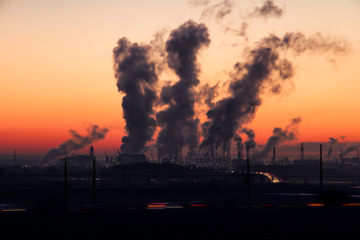![]()
Introduction:
One of the seven wonders of the world hailed as the symbol of love, the Taj mahal represents a bitter-sweet story. The uniqueness of this monument lies in the brilliant architecture of concave and convex structures and the shadows of light, the green pathways, the rich white marble along with the four minarets which give a dimension to the frame. Ustad-Ahmad Lahori was the main architect of this Indo-Iranian wonder. Built by the Mughal Emperor Shah Jahan in the loving memory of his wife Mumtaz Mahal, the work of construction started around 1632 AD.
Many legal frameworks have been designed to restore and maintain the integrity of the monument like the Ancient Monument and Archaeological Sites and Remain Act 1958 and Rules 1959 Ancient Monuments and Archaeological Sites and Remain (Amendment and Validation).[1] (Tajmahal) The Taj Trapezium Zone which was defined by an area of 10,400 sq. km around the Taj, also comprised of 40 protected monuments including the Agra Fort and Fatehpur Sikri.
The Supreme Court in 1996, delivered a judgment that banned the use of coal/coke in the industries surrounding the TTZ.
Issue
In 1996, a lawyer named M.C. Mehta filed a petition in the supreme court regarding the deteriorating condition of the monument. Due to the pollution caused by the nearby industries and factories due to residential fuel combustion, diesel trains and buses, and backup generators, the gases emitted are having harmful effects not only on the people living in residential areas around the structure but also on the monument.
The Mathura refinery and other industries release a toxic chemical called ‘sulfur dioxide’ which when combined with Oxygen, causes acid rain creating a corroding effect on the white marble. The petition states that this gas has blackened and decayed the insides of the Taj along with a yellow stain pervading it like a glove. The petitioner has sought the help of the relevant authorities to take action against this degradation and take preventive steps in the future.
Laws in Question
The petition also included a report by the Varadharajan Committee called “Report on Environmental Impact of Mathura Refinery”, which also concluded that particulate matter sourced from coal users and power plants in the Agra region is the major cause. Other factors like a Railway Shunting Yard and also as many as 250 foundries contribute to the low air quality of the zone by emitting sulfur dioxide.
The committee recommended the relocation of these industries outside Agra and the creation of an appropriate authority to monitor and limit the level of emission. The Committee also recommends that studies should be undertaken by competent agencies to explore the possibility of protecting the monuments by measures such as the provision of a green belt around Agra in the region between Mathura and Agra.
The Central Board for the Prevention and Control of Water Pollution, New Delhi, also published a report (Control of Urban Pollution Series CUPS/7/1981-82) under the title “Inventory and Assessment of Pollution Emission in and Around Agra-Mathura Region (Abridged). The report recommended the following:
- The categorization of the industrial activities as Ferrous and Non-ferrous metal casting, Rubber processing, engineering, lime oxidation, vehicular traffic, thermal power stations, and other sources.
- Closing down of the two thermal power stations and replacing coal-fired steam engines with diesel engines in the two railway marshaling yards may lead to the cut down of the harmful gas to around 50 percent.
In 1990, The National Environment Engineering Research Institute (NEERI) gave an “Over-view report” regarding the status of air pollution around The Taj.
The court passed a judgment on January 8, 1993, directing the U.P. Pollution Control Board to get a survey done of the area and prepare a list of all the industries and foundries which are the sources of pollution in the area. A notice is to be sent to all those industries on the list to ensure that the necessary measures have been taken by the said foundries. The deadline for submitting the report is May 5, 1993.
The board filed an affidavit on May 3, 1993, categorizing the industries under:
- Nature of Industry Number of Industry
- Chemical & other Industries
- Refineries in Mathura & Firozabad
- Brick Refractories & Poultries
- Block glass industries
There were 511 industries in total.
The Court dealt with the Mathura Refinery separately. The representatives for the rest of the defendants were the national chamber of Industries and Commerce, U.P., Agra, U.P. Chamber of Commerce, and the Glass Industries Syndicate.
The Board gave time to the industries listed to respond to the notices issued in two national newspapers before May 5, 1993, and also to install anti-pollution mechanisms and treatment plants if not done so.
Out of 511, 212 industries that didn’t respond were ordered to be closed by August 27, 1993, with immediate effect.
On November 19, 1993, the court recommended Mr. N.N. Goswami, a senior advocate to find out whether Gas can be used as an alternative fuel to the Glass Industries and the Foundries around Agra in place of coal. Notices were also issued to the Secretary, Ministry of Petroleum, Govt. of India, and the Chairman, Gas Authority of India.
The NEERI in its proposal dated December 19, 1993, suggested natural gas as a replacement and other cleaner fuels like ONG. As per the directives of the Hon’ble Supreme Court of India, NEERI proposed a study on the techno-economic feasibility of utilization of compressed natural gas (CNG) as a replacement of solid/liquid fuels (eg, Coal, FO, LSHS, etc.) in the industrial sectors of Agra, Mathura and Firozabad region, based on the Terms of Reference formulated by the Gas Authority of India Ltd. (GAIL).
A court order dated February 11, 1994, asked NEERI to examine the possibility of Propane as an alternative.
The Court relied on Vellore Citizens Welfare Forum v. Union of India and Ors. [2], to define the “Precautionary Principle” and “The Polluter pays principle”.
The principles as stated by the court are as follows:
- Environmental measures-by the State Government and the statutory authorities-must anticipate, prevent and attack the causes of environmental degradation.
- Where there are threats of serious and irreversible damage, lack of scientific certainty should not be sued as a reason for postponing measures to prevent environmental degradation.
- The “Onus of proof” is on the actor or the developer/industrialist to show that his action is environmentally benign.
The court accepted these principles in this case.
Judgement
The judgment was given by justices KULDIP SINGH and FAIZAN UDDIN on 30th December 1996.
The court stated that the pollution caused by the emission of coal/coke industries is the sole and major reason for the damaging effect on the Taj and the ‘onus of proof is on the industry to show that its operation with the aid of coke/coal is environmentally benign.
Further, the court ordered the 292 industries to apply to GAIL before February 15, 1997, for a grant of industrial gas connection.
Other Industries which do not opt for other natural gases were ordered to apply to the Government regarding their relocation.
The court also laid down the rights and benefits entitled by the workmen working in these 292 industries:
- The workmen will continue their employment in the new town and salaries will be paid with continuity of service.
- All those workmen who agreed to shift with the industry shall be given one year’s wages as a ‘shifting bonus’ to help them settle at the new location. The said bonus shall be paid before the deadline of January 31, 1998.
- Those workmen who did not wish to be relocated, shall be deemed to have been retrenched by May 31, 1997, provided they have been in continuous service for not less than 1 year in the industries concerned.
The court also stopped the operation of brick kilns in the TTZ area from August 15, 1996.
Conclusion
The court is monitoring the activities of the Mathura Refinery like the setting up of a hydrocracker unit, setting up of 50 hospital beds and 2 mobile dispensaries, etc.
The construction of the Agra bypass road to divert the traffic passing through the city has also been monitored which has to be completed by the end of December 1996 as stated in a court order dating April 10, 1996.
Directions have been passed to the GOI to declare Agra as a heritage city within two months and also as recommended by NEERI, the green belt has been set up around the Taj.
The court suggested the Planning Commission sanction separate allocation for the city of Agra and the creation of separate cells under the control of the Central Government to preserve the monument, the city of Agra, and other historic structures.[2]
This landmark judgment in the environmental law jurisprudence of our country has set clear guidelines regarding pollution control and also showed strict intolerance towards unlawful activities towards the environment. The rights of the employees and the workers haven’t been infringed and the displacement being strictly monitored and governed ensured non-exploitation.[3]
[1] Tajmahal. (n.d.). Retrieved from https://whc.unesco.org/en/list/252/
[2] M.C. Mehta vs Union Of India & Ors on 30 December, 1996. Retrieved from https://indiankanoon.org/doc/1964392/
[3] Dhruval. (2018, October 1). M.C. Mehta v. Union of India, 1986 – Taj Trapezium Case – Case Summary. Law Times Journal. Retrieved from https://lawtimesjournal.in/m-c-mehta-v-union-of-india-1986-taj-trapezium-case-case-summary/



0 Comments